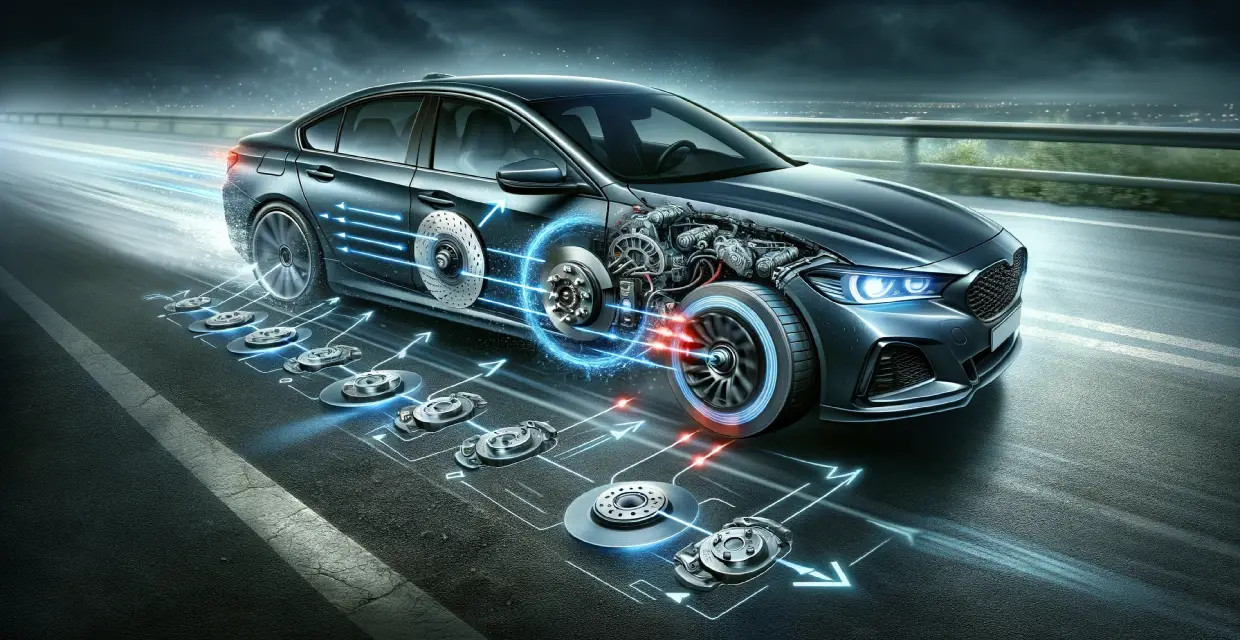

Modern Cars are equipped with multiple safety features. A crucial technology in these featuresets include EBD or the Electronic Brakeforce Distribution system. If EBD were to be summarised in a single line, it would be that it applies the braking force equally to all four wheels. This system operates on the principle that not every wheel on a car needs the same amount of braking power and is an expansion of the Anti-Lock Braking System (ABS). The technology stands as a crucial advancement in the automotive industry. Let us discuss this tech in detail and how it affects you as a car owner/ driver.
While braking, the weight of the vehicle shifts dynamically across the four wheels, and it is not necessary that each wheel will support the same amount of weight. Due to this, ultimately, the force applied on each wheel will be different too.That is where the Electronic Brakeforce Distribution or EBD steps in.Traditional braking systems lacked the sophistication to adapt to these variations, often leading to loss of traction and compromised control.
Also Read:- What is ADAS in Cars
The EBD utilises specialised speed sensors connected to each wheel, that transmit the speed of the wheel to the control unit. The unit then determines whether the slip ratio of each wheel is below the threshold or not. This slip ratio is calculated by comparing the speed of the wheel to the speed of the car. In case the sensors detect slipping, the brake force modulators trigger brakes with right force, just to slow down the vehicle, or to completely stop it.
Upon detecting a discrepancy indicating potential wheel slippage, the ECU orchestrates the intervention of brake force modulators. These modulators adjust the braking force applied to individual wheels, ensuring optimal traction and stability. By dynamically distributing braking force, EBD mitigates the risk of skidding and loss of control, especially in adverse driving conditions.
Also Read:- Best Car for Long Distance Trip
Speed Sensors: These are found in each wheel and act as the eyes of the EBD system. They are constantly providing real-time feedback to the ECU, and helps it make informed decisions regarding the force allocated while braking. The main point to consider is that if the vehicle speed is more than the speed at which the wheel(s) is (are) rotating, then there are very high chances of vehicle skidding and hence the EBD system kicks into action.
Electronic Control Unit (ECU): Acting as the brain of the system, the ECU processes data from speed sensors and orchestrates the modulation of brake force. It continuously evaluates the vehicle's dynamics to maintain optimal braking performance.
Brake Force Modulators: These are the executing components of the system. Responsible for adjusting the hydraulic pressure applied to individual brake circuits, the brake force modulators are independently acting on each wheel. They are also responsible for fine tuning the force distribution, which results in more precise control, while the vehicle is decelerating.
Also Read:- Most Expensive Cars in the World
The main advantage of EBD is that it ensures that the right amount of force is applied to each wheel according to the weight supported by it. Under its absence, all the wheels will be applied with the same braking force, irrespective of the traction and the weight supported. That could result in the wheel slipping and hence, a loss of control for the vehicle. EBD system ensures that this does not happen. Some other advantages of EBD include:
Enhanced Stability: By preventing wheel lock-up and optimising traction, EBD enhances vehicle stability during braking, reducing the risk of skidding and loss of control.
Improved Brake Performance: EBD ensures that each wheel receives the appropriate amount of braking force, maximising stopping power and reducing stopping distances.
Adaptability to Varied Conditions: Whether driving on dry pavement or slippery surfaces, EBD adjusts brake force distribution to suit prevailing conditions, ensuring consistent performance across diverse driving scenarios.
Safety Enhancement: By minimising the likelihood of accidents resulting from loss of control during braking, EBD contributes to overall road safety, protecting both occupants and other road users.
Also Read:- Most Expensive Cars in India
EBD and ABS are two important braking technologies in cars that work differently. EBD balances brake force between front and rear wheels for more stable braking. ABS prevents wheel lockup during hard braking by rapidly pulsing the brakes, helping maintain steering control and reduce stopping distance on slippery roads. While both improve braking, ABS has a more noticeable effect in emergency situations. EBD is a standard feature on most vehicles now. ABS became common by the late 1990s but was an option on lower-end models until the early 2000s.
In conclusion, Electronic Brakeforce Distribution represents a significant advancement in automotive safety technology, offering precise control over braking performance. By intelligently allocating braking force to individual wheels, EBD enhances stability, traction, and control, thereby reducing the risk of accidents and improving overall driving safety. As vehicles continue to evolve, EBD stands as a vital component in the quest for safer and more efficient transportation. For more information about cars and all car technologies, stay tuned with Park+.